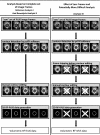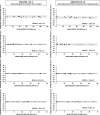Impact of analyzing less image frames per segment for radiofrequency-based volumetric intravascular ultrasound measurements in mild-to-moderate coronary atherosclerosis
- PMID: 20191323
- PMCID: PMC2868170
- DOI: 10.1007/s10554-010-9599-y
Impact of analyzing less image frames per segment for radiofrequency-based volumetric intravascular ultrasound measurements in mild-to-moderate coronary atherosclerosis
Abstract
Volumetric radiofrequency-based intravascular ultrasound (RF-IVUS) data of coronary segments are increasingly used as endpoints in serial trials of novel anti-atherosclerotic therapies. In a relatively time-consuming process, vessel and lumen contours are defined; these contours are first automatically detected, then visually checked, and finally (in most cases) manually edited to generate reliable volumetric data of vessel geometry and plaque composition. Reduction in number of cross-sectional images for volumetric analysis could save analysis time but may also increase measurement variability of volumetric data. To assess whether a 50% reduction in number of frames per segment (every second frame) alters the reproducibility of volumetric measurements, we performed repeated RF-IVUS analyses of 15 coronary segments with mild-to-moderate atherosclerosis (20.2 +/- 0.2 mm-long segments with 46 +/- 13% plaque burden). Volumes were calculated based on a total of 731 image frames. Reducing the number of cross-sectional image frames for volumetric measurements saved analysis time (38 +/- 9 vs. 68 +/- 17 min/segment; P < 0.0001) and resulted for only a few parameters in (borderline) significant but mild differences versus measurements based on all frames (fibrous volume, P < 0.05; necrotic-core volume, P = 0.07). Compared to the intra-observer variability, there was a mild increase in measurement variability for most geometrical and compositional volumetric RF-IVUS parameters. In RF-IVUS studies of mild-to-moderate coronary disease, analyzing less image frames saved analysis time, left most volumetric parameters greatly unaffected, and resulted in a no more than mild increase in measurement variability of volumetric data.
Figures
References
-
- Bruining N, von Birgelen C, de Feyter PJ, Ligthart J, Li W, Serruys PW, Roelandt JR. ECG-gated versus nongated three-dimensional intracoronary ultrasound analysis: implications for volumetric measurements. Cathet Cardiovasc Diagn. 1998;43(3):254–260. doi: 10.1002/(SICI)1097-0304(199803)43:3<254::AID-CCD3>3.0.CO;2-8. - DOI - PubMed
-
- Mintz GS, Nissen SE, Anderson WD, Bailey SR, Erbel R, Fitzgerald PJ, Pinto FJ, Rosenfield K, Siegel RJ, Tuzcu EM, Yock PG. American college of cardiology clinical expert consensus document on standards for acquisition, measurement and reporting of intravascular ultrasound studies (IVUS). A report of the American college of cardiology task force on clinical expert consensus documents. J Am Coll Cardiol. 2001;37(5):1478–1492. doi: 10.1016/S0735-1097(01)01175-5. - DOI - PubMed
-
- von Birgelen C, de Vrey EA, Mintz GS, Nicosia A, Bruining N, Li W, Slager CJ, Roelandt JR, Serruys PW, de Feyter PJ. ECG-gated three-dimensional intravascular ultrasound: feasibility and reproducibility of the automated analysis of coronary lumen and atherosclerotic plaque dimensions in humans. Circulation. 1997;96(9):2944–2952. - PubMed
MeSH terms
LinkOut - more resources
Full Text Sources
Medical




